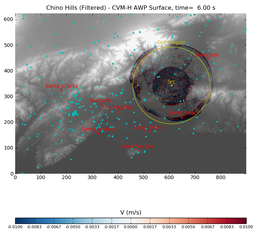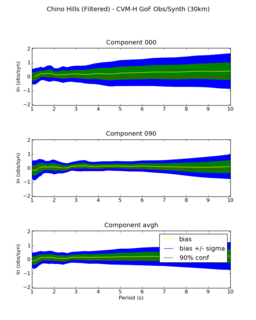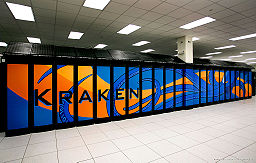Difference between revisions of "CVM-H Acceptance Test Framework Validation"
| Line 21: | Line 21: | ||
[[File:Kraken.jpg|256px|thumb|right|Fig 3: TeraGrid - Kraken.]] | [[File:Kraken.jpg|256px|thumb|right|Fig 3: TeraGrid - Kraken.]] | ||
| + | |||
| + | |||
| + | == Wave Propagation Simulation Parameters == | ||
| + | |||
| + | Specifications for the current CVM evaluation simulation are as follows: | ||
| + | * input mesh volume size: 180km x 125km x 60km | ||
| + | * input mesh grid spacing: 100m | ||
| + | * input mesh nx,ny,nz: 1800x1250x600 | ||
| + | * output surface nx,ny: 900x625 (ie: decimated by factor of 2) | ||
| + | * second simulated: 120 s | ||
| + | * Max Vp in mesh = 8300 m/s | ||
| + | * Min Vs in mesh = 500 m/s | ||
| + | * sim dt: 0.006s | ||
| + | * time steps in sim: 20000 | ||
| + | * cores used in sim: 7200 | ||
Revision as of 22:07, 9 December 2010
An acceptance test framework to test and compare the performance of various Community Velocity Models (CVM) was designed by Patrick Small. This framework uses CruiseControl, a continuous integration tool and an extensible framework for creating a custom continuous build and test process for the CVMs. CruiseControl is setup on one of the SCEC development servers and can be configured to use a specific user's TeraGrid credentials. Once setup with appropriate Grid Proxy certificates, CruiseControl can remotely deploy required source code and test data on the TeraGrid resource and perform an end to end test.
To validate this test framework,
- CruiseControl was setup on a community account on AfterShock - a SCEC development server.
- A specific user's TeraGrid credential was linked to this account.
- CruiseControl was configured to run a build and test job on Kraken - a TeraGrid resource.
- At the specified time CruiseControl,
- Transferred all the required build scripts and source data to Kraken. - Necessary source code was checked out from SVN by the build scripts. - The CVM code was built and required mesh was extracted. - The wave propagation code was built and run by script. - The generated synthetic waveforms (seismogram) data was collected and plotted. - The synthetic waveform data was compared to the observed waveform data and goodness-of-fit (GOF) curves were plotted. - A HTML page was generated by an automated script to summarize the test results.
A set of test results generated by Patrick can be found here: http://earth.usc.edu/~patrices/cvm-t/
An example test result page can be found here: Simulation of Chino Hills (Filtered) event at 1Hz with material properties provided by CVM-H
Wave Propagation Simulation Parameters
Specifications for the current CVM evaluation simulation are as follows:
- input mesh volume size: 180km x 125km x 60km
- input mesh grid spacing: 100m
- input mesh nx,ny,nz: 1800x1250x600
- output surface nx,ny: 900x625 (ie: decimated by factor of 2)
- second simulated: 120 s
- Max Vp in mesh = 8300 m/s
- Min Vs in mesh = 500 m/s
- sim dt: 0.006s
- time steps in sim: 20000
- cores used in sim: 7200


